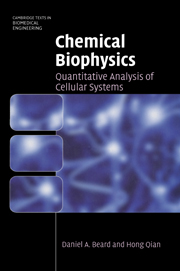Book contents
- Frontmatter
- Contents
- Preface
- Introduction
- Part I Background material
- Part II Analysis and modeling of biochemical systems
- Part III Special topics
- 8 Spatially distributed systems and reaction–diffusion modeling
- 9 Constraint-based analysis of biochemical systems
- 10 Biomacromolecular structure and molecular association
- 11 Stochastic biochemical systems and the chemical master equation
- 12 Appendix: the statistical basis of thermodynamics
- Bibliography
- Index
9 - Constraint-based analysis of biochemical systems
Published online by Cambridge University Press: 05 June 2012
- Frontmatter
- Contents
- Preface
- Introduction
- Part I Background material
- Part II Analysis and modeling of biochemical systems
- Part III Special topics
- 8 Spatially distributed systems and reaction–diffusion modeling
- 9 Constraint-based analysis of biochemical systems
- 10 Biomacromolecular structure and molecular association
- 11 Stochastic biochemical systems and the chemical master equation
- 12 Appendix: the statistical basis of thermodynamics
- Bibliography
- Index
Summary
Overview
When mechanistic information is available or obtainable for the components of a system, it is possible to develop detailed analyses and simulations of that system. Such analyses and simulations may be deterministic or stochastic in nature. (Stochastic systems are the subject of Chapter 11.) In either case, the overriding philosophy is to apply mechanistic rules to predict behavior. Often, however, the information required to develop mechanistic models accounting for details such as enzyme and transporter kinetics and precisely predicting biochemical states is not available. Instead, all that may be known reliably about certain large-scale systems is the stoichiometry of the participating reactions. As we shall see in this chapter, this stoichiometric information is sometimes enough to make certain concrete determinations about the feasible operation of biochemical networks.
Analysis of biochemical systems, with their behaviors constrained by the known system stoichiometry, falls under the broad heading constraint-based analysis, a methodology that allows us to explore computationally metabolic fluxes and concentrations constrained by the physical chemical laws of mass conservation and thermodynamics. This chapter introduces the mathematical formulation of the constraints on reaction fluxes and reactant concentrations that arise from the stoichiometry of an integrated network and are the basis of constraint-based analysis.
As we shall see, linear algebraic constraints arising from steady state mass balance form the basis of metabolic flux analysis (MFA) and flux balance analysis (FBA).
- Type
- Chapter
- Information
- Chemical BiophysicsQuantitative Analysis of Cellular Systems, pp. 220 - 239Publisher: Cambridge University PressPrint publication year: 2008



